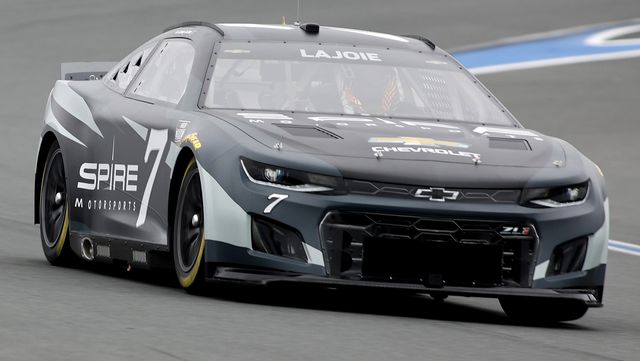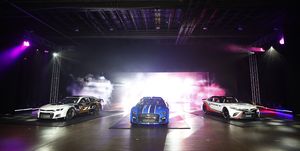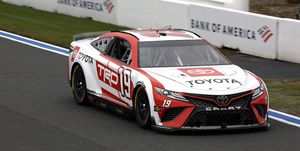Hype and Hoopla Come Cheap for NASCAR’S Next Gen
Wayne is a home builder from Virginia, a middle-aged family man who knows more about cars than most of us. He’s been a NASCAR fan his entire life, but not just another fan: he was a decent Late Model racer who became a successful short-track promoter. He’s an acknowledged “car guy” with close connections within the racing and commercial automotive communities.
If there’s anyone who should know about the Next Gen car (Gen 7 for those scoring at home), it’s him. It’s his view that the average Cup Series fan won’t judge the 2022 models until next spring, when they actually see the car at speed. In Daytona Beach, hype and hoopla come cheap; in reality, the proof is in the pudding.
“I think people will give it time before they decide,” Wayne said recently. “It looks good sitting still, but not many people have seen it in motion. Maybe on TV or in a video, but not in person. And when they see it on-track, they’ll see mostly the cosmetic stuff. NASCAR brags about its technical advances, but how many fans care about that? I do, but I don’t know how many others will.”
Among those technical advances, Wayne expects drivers and teams to be most excited about improved drivability. “NASCAR really wants to get rid of the ‘dirty air’ that affects racing,” he said. “This car will stop better and turn better and hug the race track better. One thing it will do is close up the field and make competition better. That’s what they hope.”
Wayne (no last names will be used here) was among a dozen fans recently polled about the Next Gen car. Some knew enough to know they didn’t know enough to offer insight. Others knew nothing except what NASCAR has told them. A few thought the subject was “electric cars,” something they absolutely don’t want. A handful—they can be found almost anywhere—simply wanted to rail against NASCAR on general principle.
What’s All the Fuss About?
The much-ballyhooed Next Gen car is the new piece designed to contain costs and more closely mimic today’s production-based, street-legal, sporty-looking coupes. They boast cutting-edge technology similar to Australia’s popular Supercars and IMSA’s GT3 class. A single supplier in Jackson, Michigan will provide frames with a center roll cage and bolt-on front and rear clips. The idea is that damaged clips can easily be replaced instead of trashing the entire frame if it can’t be salvaged.
Technical changes far outnumber what fans will see. From the grandstands at speed, they won’t notice the carbon fiber-reinforced plastic body panels. They may never see the underwing and rear-end diffuser that will help handling and reduce dirty air. They won’t see the rack-and-pinion steering, the independent rear suspension, or the 5-speed transaxle. They’ll recognize the larger aluminum wheels and tires, but not the larger brakes. They can’t miss the two exhaust pipes extending from beneath each side or the single center-lock Indy-style wheel nut. The differences are in inches, so they may not immediately notice the car is somewhat lower, shorter, and wider than current models.
Strictly speaking, the 2022 cars are the seventh version of the “stock car” that NASCAR introduced in 1949. Each version has been different from its predecessor in ways great and small. Many of the changes were safety-related; others were inspired by Detroit’s evolving body shapes and styles. Dimensions have varied. Spoilers, splitters, roof railings, ride-heights, and all manner of templates have defined the on-track product. Never has NASCAR spent this much time, money, and creativity to bring a new car to life.
Officials inaugurated the Next Gen concept more than two years ago with hopes of a 2021 rollout. But the pandemic changed everything, giving teams with adequate manpower and resources the challenge of racing today’s car while working on next year’s. Those teams have spent untold man-hours and millions of dollars on the project. NASCAR’s marketing and PR machine has worked tirelessly to promote the new car, stressing excitement and pleading for acceptance from its fanbase.
It’s difficult to tell if the message is catching on. Older fans want to cling to what attracted them in the 80’s, 90’s and early this century. Newer fans—and there are increasingly fewer of them—are drawn to the spectacle and hospitality as much as the racing itself. NASCAR is hoping against hope the new car will help get the series back on solid footing.
Fans Worry About ‘New Direction’
“I grew up around NASCAR, and I’m an old-school fan who wants to keep traditions in place,” said Marshall, a North Carolinian at last month’s Bank of America 400 near Charlotte. “I’ve seen pictures of the new car, but haven’t seen it on a track. I don’t know enough about it except that I don’t like the single lug nut because that takes away from the pit stop excitement. From what I’ve seen on TV, the car doesn’t look that much different from today’s car. But overall … yeah, I’m excited about something new next year.”
Jason, also at the BOA 400, worries more about NASCAR’s “new direction” than about the Next Gen car. “Us old-time fans want racing as much like it used to be as they can make it,” he said. “The racing today is similar to what it’s always been, but it’s 50/50 whether it’s better now than 20 or 25 years ago. A lot of us want to go back to North Wilkesboro (N.C.) and Rockingham (N.C.). We want two races at Darlington. NASCAR has gone out West too much. It’s getting away from what made it great.
“They say this new car will make racing better, but nobody knows. Personally, I’m a fan of quality and performance and reliability in race cars. Things change all the time and that doesn’t bother me. But I don’t care much about rack-and-pinion steering or that new rear suspension or the transmission. I don’t know if anybody’s going to be excited about stuff like that. I don’t know that technical stuff like on these cars matter that much to today’s fans.”
Many of “today’s fans” speak of 20 to 25 years ago as “the good ol’ days.” Trey and Rusty are from around Charlotte and have been NASCAR fans (they proudly brag) for almost 50 years. They still love the sport, but worry for its future. They talked over each other so quickly that it was hard to tell one from the other.
“Man, they let ‘em really race back in the 70s and 80s,” they said almost together. “Yeah, there was money back then, but not like today, when it seems like everything is about money more than racing. And back then the cars on the race track looked more like the cars in the showroom. A lot has changed and that’s okay, but nothing is like it was when Earnhardt was racing. NASCAR lost a lot when it lost him.
“As for this new car: are you talking about electric race cars? No? Oh, good.”
“As for this new car: are you talking about electric race cars? No? Oh, good. Personally, I (both nodded) don’t care about what makes the cars run as long as they run fast and put on an exciting show. That’s all I care about.” (They both nodded again). “Rack-and-pinion steering doesn’t excite me. I don’t like the idea of the one lug nut. I mean, can it hold on a wheel at 200 miles an hour? Really … I don’t care what the car looks like as long as it’s a Ford or Toyota or Chevrolet. I wouldn’t buy anything that’s not racing out here.”
Wyatt is from western Virginia, close enough to drive to Bristol, Martinsville, Nashville, Charlotte, and Richmond. He’s excited about the new car, as much for the technical and mechanical changes as for the visual. But like so many others, he’s waiting to see a full field with points and money on the line.
“I’m hoping the composite body will reduce tire rub and cut tires that cause wrecks,” he said. “I’m excited about that. And I’m looking forward to the technical changes. The pit stops will be different because they can change tires before getting the fuel load in. That’s probably going to affect race strategy. It’ll be excited.”
Sean and Brandy from West Virginia like the idea that NASCAR is taking steps forward after years with the current car. “It’s cool that they’re trying new stuff inside the car and also changing how it looks on the outside,” Sean says. “Maybe it’ll give smaller teams more of a chance.”
Brandy had her own take 0n the Next Gen car: “I like how it looks,” she said, “but let’s wait and see how it races. That’s the most important thing.”
The pudding … remember?
Source: Read Full Article










